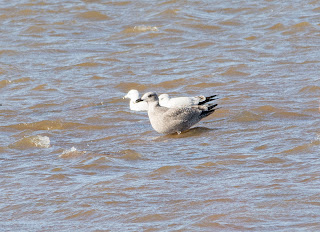This rare but increasing winter resident from Europe tends to come to Oklahoma on practically a yearly basis. First noticed in 2008 at Boomer Lake Park in Stillwater, this gull comes to Oklahoma frequently in winter, as well as other parts of the state, including Lake Hefner, Lake Yahola, Keystone Dam, and other areas including the Panhandle. It usually mixes in among the Ring-billed and Herring Gulls, usually noted for its larger size, smudged dark spot around the eye, and pale yellow juvenile legs.
They are usually found all over the Atlantic coast in winter, then gradually lessen as they get to inland areas of the US. It looks similar to the Herring Gull, but is a little smaller and the bill shape also helps to give away its identity.
Lesser Black-backed Gull
Boomer Lake Park, 2016
It is suspected that these birds come from Greenland or Iceland, where the latter has had older colonies. As of 2007, two different birds paired with two Herring Gulls to become nesting birds in the States, which was in Maine and Alaska. It first arrived in the US in 1934.
The call is a deeper laugh than the Herring Gull. which also helps to draw attention to it. Young birds have scaly dark brown feathers with black primaries, a neat pattern on the wings, and takes four years to mature. They are also omnivores, like most other gulls, and will join other species at a local dump, or eat invertebrates and fish at bodies of water. They are also kleptoparasites.

No comments:
Post a Comment